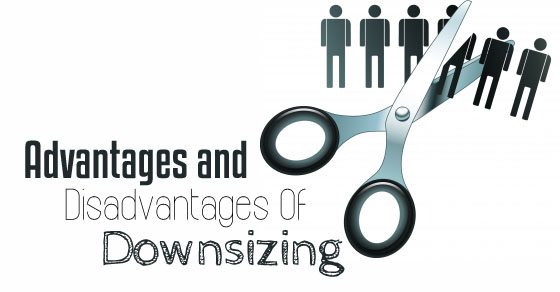Downsizing is a word that everyone hears once in a while when the market is down when the company doesn’t perform too well, when the company merges with another firm or when the company breaks up.
Through this company’s downsizing, the employer tends to reduce their manpower or eliminate human resources.
There are many reasons for downsizing employees of a company and it has its own advantages and disadvantages.
Reviewing some of the aspects of downsizing will help one to understand better.
 Image Source: iresearchnet
Image Source: iresearchnet
What is Downsizing?
When the management finds out that their company is not performing well and their operating costs are high, then the company looks out to find ways to optimize their productivity.
One of the most often sought out immediate measure is to reduce manpower by firing employees or reduce the payroll payment. This is termed as organizational downsizing which is a reduction in organizational size and operating costs to improve efficiency, productivity, and competitiveness.
But the organization would need to operate with the reduced manpower and perform the same workload that existed before downsizing.
Reasons for Downsizing Companies:
Downsizing is done to restructure, revamp the whole setup, increase company value to eliminate excess costs and create unemployment as well.
Also, downsizing happens when the company would be vying to find a suitable candidate to increase their productivity.
When an employer wants to streamline or restructure a company to increase profitability or maximize efficiency.
Another prominent factor is when two companies, the management changes the way their process operates. This operation would not require all the manpower. That’s when they would think about downsizing.
Even when the company acquires another company the same could happen.
So why do they do it?
1. Performance low:
Why do companies downsize?
It is because when the performance goes below their target for a certain period of time. This could be due to market trends or when the competitor’s prices are less than theirs.
Besides, when products sold or services rendered have not modified as per the customer changing needs, then performances go down.
2. Reducing costs:
As it is known that payroll is considered the liability on the balance sheet, the only thing that a company could cut costs is to keep their hands on the payroll payment. It’s not only payroll but the benefits that go along with it.
3. Increase productivity:
Companies know that while remaining constant with productivity they can increase the productivity of individuals.
It can be advantageous while cost reduction factor is considered. Sometimes, individuals can be replaced with sophisticated equipment to increase productivity.
4. Increase value:
Through this process, there are signals sent out to shareholders and investors that changes are inevitable to increase profitability.
This could help investors in increasing their shareholding, thereby their value increase.
5. Sharpen focus:
Sometimes companies would be interested in focusing their attention on some aspects by outsourcing some of their functions which are time to consume. This indirectly reduces its cost.
What are the Effects of Downsizing on Employees?
Downsizing is a process of laying off people wherein the laying off could be permanent or temporary.
Temporary could relate with hiring after restructuring, converting them to temporary staff, part-timers.
After downsizing, the next steps that follow could be
- Closing a branch or a department
- Merging a department with another
- Consolidating job duties
- Job sharing
- Cutting down of employees benefits
- Reduction in a workweek
- Bringing in changes to day to day work activities
A person has to be prepared for this from the warning signs like closed-door meetings, rumors spreading about taking over when the hiring process stops.
When you are aware of it then prepare your CV and start searching through your networks.
Types of Downsizing:
There are various ways that the downsizing process goes about. But the foremost aspect is that the employees should leave the company with dignity. Let us see the various types of downsizing.
1. Reducing the workforce:
This is the most common method followed wherein employees are laid off bringing in early retirement and thereby transferring individuals to critical positions.
The aim here is to reduce unnecessary positions and thereby headcount.
The employer must be professional in handling this situation which can be done by calling the meeting with the team members.
But before embarking on this downsizing strategy, the employer needs to re-organize the company to know where or which section needs a downsizing.
Some examples are freezing of the hiring process, early retirement packages, retrenchments, natural attrition, and layoffs.
2. Redesigning work:
The purpose of redesigning focuses on eliminating unnecessary work that means vacant positions.
The positions that lie vacant are duly eliminated and thereby the duties are transferred to another function through redesigning. Sometimes redesigning work functions works well during mergers.
Examples are an abolition of functions, job redesigning, reducing work hours, de-layering, and merging of units.
3. Approaching the system:
Making changes to the system in the organization is making cultural changes so that it would ultimately bring in reducing costs.
This has the positive impact of increasing productivity which the employees generally appreciate. The results are mostly long term rather than short term.
Not focusing on job losses or company gaining, the emphasis is on the customer’s service that leads to profitability. This approach is effective during a major crisis and financial difficulty.
Also Read:
- Organizational Restructuring: Strategies and Benefits
- Difference Between Downsizing and Restructuring
Effective Downsizing Strategies:
Downsizing is a step that organizations take to maintain and survive in the competitive market. It can also be considered as a precautionary step to make their future stable. Downsizing is a tough strategy and even employers hate to take such step as sometimes it looks little unethical.
But to save the business and sustain in the market, one has to use a downsizing strategy to avoid financial drain and to become steady. The best thing the employers or organizations can do is to downsizing a business with dignity. Here are a few tips that you need to follow during the downsizing procedure.
- Respect your employees’ dignity
- Making things happen effectively
- Try alternatives for downsizing
- Preventing the ineffective methods of downsizing
- Take proper legal concerns during layoffs
- Do not be biased when layoffs
- Think about the after-effects
- The survivors need to be motivated to the new changes
- Effective communication with employees
| Benefits of Downsizing Employees | Disadvantages of Downsizing Employees |
| Losing staff | Saving business |
| Losing credibility | Bringing transparency |
| Affects the bottom line | Lean operations |
| Fewer opportunities | Retains talent |
| Negative public perception | Brings in teamwork |
| Affects decision making | Strengthen relations |
| Spoils reputation | Running optimal |
| Disrupt in communications | Direct interaction |
| The loss of knowledge | Re-evaluate business |
| Burdening responsibilities | Bringing to a manageable size |
Pros and Cons of Downsizing in Companies:
As downsizing is a process where the company makes changes in its structure and operations, it does have its own advantages and disadvantages.
In other words, we need to rephrase as negative and positive aspects of downsizing.
Benefits of Downsizing Employees:
1. Losing staff:
As reducing manpower is the criteria most of the times, some of the functions are merged to eliminate redundancy.
When there is the merging of functions, there is a need to let go of some of the employees. There could be no other option other than letting go of staff to meet the financial crunch.
2. Losing credibility:
Companies that have many links with vendors and other customers would see that vendors become more hesitant in continuing business with them as downsizing business is considered as a sign of bad financial phase.
Creditors would be even thinking twice whether to proceed. Though the company may not be actually downsizing due to the financials, the overall picture on the credibility takes a hit.
3. Affects the bottom line:
As downsizing is mainly reducing the burden on financial, it indirectly affects the overall bottom line.
Like for instance, if there is a reduction of manpower, then it would directly hit the production or services as it would be reduced when compared to the previous.
Though it may seem that it will increase efficiency, it may not be so.
4. Fewer opportunities:
As downsizing is said to be reducing the positions, those who are held back in the organizations cannot look forward to opportunities for growth within the framework.
Hence, it would not be an ideal place for those who wish to see a growth in their career as the options are limited or nil.
5. Negative public perception:
Most of the time, businesses who don’t declare their downsizing reasons create a negative impact on their image in the eyes of the public.
They seem to others as unprofitable or failing business thereby decreasing clients due to misconceptions. Misconceptions can be avoided by being vocal of the reasons for downsizing.
6. Affects decision making:
Letting go of people or removing people from functions would impact the decision-making process of various activities that may be required. The view or opinions of those who departed cannot be gathered or would be missing.
7. Spoils reputation:
If downsizing is done due to outsourcing the work, then the former employees would be unhappy.
Such employees would be a source of public relations and could spoil the reputation of the company.
This would bring a drop in revenue, repeat customers and new customers would refrain from building the business.
8. Disrupt in communications:
The factor of information sharing is disrupted as structures get changed. With such disruption, the flow of information for executing projects gets hampered as decision making and exchange of ideas are not carried out effectively.
The normal conversations during coffee breaks also get hampered.
9. The loss of knowledge:
Downsizing would definitely bring in the loss of skill sets and knowledge gained through the years.
Everyone is not an expert in everything. Each employee has some skill set that may not be present in the other.
For instance, an employee may be the low performer but he may have expertise in a certain function that helped in the working of the project. By downsizing such expertise is the loss.
10. Burdening responsibilities:
Downsizing is a process of reducing manpower or restructuring or reshaping the processes.
All of these have a negative impact on the employees who are retained who fear for their service, stressed out due to additional responsibilities and requirements impacting the quality of work.
Disadvantages of Downsizing Employees:
1. Saving business:
Whatever be disadvantaged, one way of downsizing would, in fact, help the company to bring the business on track.
The unnecessary activities that were redundant would be done with. Besides the financial stability could be restored as there would be cost cuts to additional expenses.
2. Bringing transparency:
Downsizing companies would need to make results transparent for the employees to see the real trends.
In fact, transparency brings in more co-operation within the group and within the team.
The displays of the production or the turn over to employees could be in terms of charts or pie charts or even month on month achievements. This is actually a morale booster.
3. Lean operations:
When the company downsizes it would be operating at reduced costs by avoiding unnecessary expenditures and looking into details of any process to see that there is no unnecessary costs.
This way the profits increase and the company is said to perform under lean management. So the company needs to review the downsized plans and follow them practically.
4. Retains talent:
It’s a fact that downsizing cuts down manpower wherein the management needs to pay more attention to the low performing employees so that they could be targeted first.
This cannot be achieved in a short span of time but needs to be taken care of during the performing time itself.
5. Brings in teamwork:
As the team gets smaller, the management would need to focus on rebuilding the new team by focusing on training, incentive programs. This would create loyalty, motivation and empowers them directly impacting on productivity.
With the opening up of various communication channels, employees help to solve problems that may arise.
6. Strengthen relations:
Through the process of downsizing, the company can take measures of reducing the working hours. It could be in terms of days per week or hours per day.
It might impact some workers who would leave but those who stay back are the loyal team who the company relies on. Their loyalty strengthens the relationship between employer and employee.
7. Running optimal:
Downsizing actually brings in cuts and changes to all the departments in the organization.
Hence, there is a balance created within each section which contributes to the cost-cutting approach. Due to this everyone is involved in allowing the business to run at optimal.
8. Direct interaction:
As downsizing is a way to reduce all-round costs, the top management that did not involve in day to day activities would do so hereafter.
This way the owner of the business would be involved in decision making of all the projects or tasks. This helps to bring in more control of the business.
9. Re-evaluate business:
It is a chance for the business to re-look at its operations and strategies for growth. Re-evaluating helps the company to rewrite its business plans to suit the market trends.
This helps the business to review and update its policies, procedure of operation and bring changes.
By doing so, it allows the company to position itself better in the competitive world of business for the future.
10. Bringing to a manageable size:
Downsizing is actually to reduce the operations and size of the department so that it is manageable.
It helps the business to serve customers efficiently as the situation is manageable. When the situation is manageable the profit is good.







































